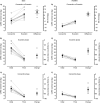Muscle strength and activity in men and women performing maximal effort biceps curl exercise on a new machine that automates eccentric overload and drop setting
- PMID: 36856799
- PMCID: PMC10191922
- DOI: 10.1007/s00421-023-05157-9
Muscle strength and activity in men and women performing maximal effort biceps curl exercise on a new machine that automates eccentric overload and drop setting
Abstract
Purpose: Connected adaptive resistance exercise (CARE) machines are new equipment purported to adjust resistances within and between repetitions to make eccentric (ECC) overload and drop sets more feasible. Here, we examined muscle strength, endurance, electromyographic activity (EMG), and perceptions of fatigue during unilateral bicep curl exercise with a CARE machine and dumbbells. We also tested for sex differences in muscle fatigability.
Methods: Twelve men and nine women attempted 25 consecutive coupled maximal ECC-concentric (CON) repetitions (ECCmax-CONmax) on a CARE machine. Participants also completed a CON one repetition maximum (1RM) and repetitions-to-failure tests with 60 and 80% 1RM dumbbells.
Results: Maximal strength on the CARE machine was greater during the ECC than CON phase, illustrating ECC overload (men: 27.1 ± 6.8, 14.7 ± 2.0 kg; women: 16.7 ± 4.7, 7.6 ± 1.4 kg). These maximal resistances demanded large neural drive. Biceps brachii EMG amplitude relative to CON dumbbell 1RM EMG was 140.1 ± 40.2% (ECC) and 96.7 ± 25.0% (CON) for men and 165.1 ± 61.1% (ECC) and 89.4 ± 20.4% (CON) for women. The machine's drop setting algorithm permitted 25 consecutive maximal effort repetitions without stopping. By comparison, participants completed fewer repetitions-to-failure with the submaximal dumbbells (e.g., 60%1RM-men: 12.3 ± 4.4; women: 15.6 ± 4.7 repetitions). By the 25th CARE repetition, participants reported heightened biceps fatigue (~ 8 of 10) and exhibited large decreases in ECC strength (men: 63.5 ± 11.6%; women: 44.1 ± 8.0%), CON strength (men: 77.5 ± 6.5%; women: 62.5 ± 12.8%), ECC EMG (men: 38.6 ± 20.4%; women: 26.2 ± 18.3%), and CON EMG (men: 36.8 ± 20.4%; women: 23.1 ± 18.4%).
Conclusion: ECC overload and drop sets occurred automatically and feasibly with CARE technology and caused greater strength and EMG loss in men than women.
Keywords: Bicep curl; Eccentric; Muscle fatigue; Resistance exercise; Sex difference.
© 2023. The Author(s).
Conflict of interest statement
The authors have no conflict of interests to report.
Figures







Similar articles
-
Muscle fatigue during maximal eccentric-only, concentric-only, and eccentric-concentric bicep curl exercise with automated drop setting.Scand J Med Sci Sports. 2023 Jun;33(6):857-871. doi: 10.1111/sms.14330. Epub 2023 Feb 16. Scand J Med Sci Sports. 2023. PMID: 36752667
-
One-Repetition Maximum and Repetitions to Failure at Submaximal Intensity in Eccentric-Only, Concentric-Only, and Conventional Arm Curl, Bench Press, and Back Squat Exercises.J Strength Cond Res. 2025 May 1;39(5):515-522. doi: 10.1519/JSC.0000000000005046. Epub 2025 Mar 4. J Strength Cond Res. 2025. PMID: 40266635
-
Comparison in Repetitions to Failure Between Concentric-Only and Eccentric-Only Dumbbell Arm Curl Exercise at Four Different Relative Intensities.J Strength Cond Res. 2023 Sep 1;37(9):1754-1760. doi: 10.1519/JSC.0000000000004470. Epub 2023 Jan 18. J Strength Cond Res. 2023. PMID: 36728005
-
Overview of muscle fatigue differences between maximal eccentric and concentric resistance exercise.Scand J Med Sci Sports. 2023 Oct;33(10):1901-1915. doi: 10.1111/sms.14419. Epub 2023 Jun 2. Scand J Med Sci Sports. 2023. PMID: 37269142 Review.
-
The Eccentric:Concentric Strength Ratio of Human Skeletal Muscle In Vivo: Meta-analysis of the Influences of Sex, Age, Joint Action, and Velocity.Sports Med. 2023 Jun;53(6):1125-1136. doi: 10.1007/s40279-023-01851-y. Epub 2023 May 2. Sports Med. 2023. PMID: 37129779 Free PMC article. Review.
Cited by
-
Maximal Number of Repetitions at Percentages of the One Repetition Maximum: A Meta-Regression and Moderator Analysis of Sex, Age, Training Status, and Exercise.Sports Med. 2024 Feb;54(2):303-321. doi: 10.1007/s40279-023-01937-7. Epub 2023 Oct 4. Sports Med. 2024. PMID: 37792272 Free PMC article. Review.
-
Resistance Exercise Minimal Dose Strategies for Increasing Muscle Strength in the General Population: an Overview.Sports Med. 2024 May;54(5):1139-1162. doi: 10.1007/s40279-024-02009-0. Epub 2024 Mar 20. Sports Med. 2024. PMID: 38509414 Free PMC article. Review.
-
Sex differences in fatiguability during single-joint resistance exercise in a resistance-trained population.Eur J Appl Physiol. 2024 Aug;124(8):2261-2271. doi: 10.1007/s00421-024-05445-y. Epub 2024 Mar 5. Eur J Appl Physiol. 2024. PMID: 38441692
References
MeSH terms
LinkOut - more resources
Full Text Sources

